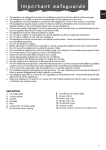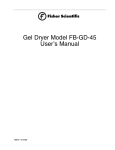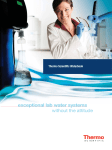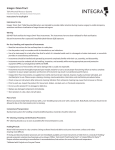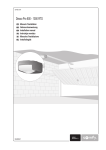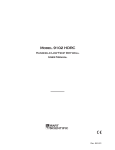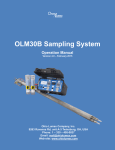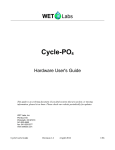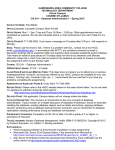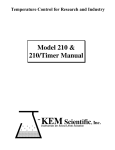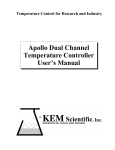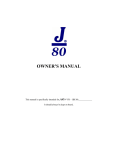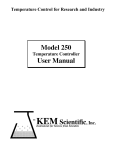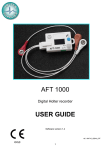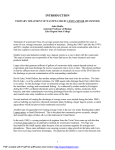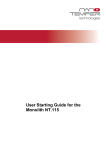Download here
Transcript
Imperial III General Purpose Incubators Series 1464, 1465, 1466 Model No. Gravity Convection: 302, 302-1 305, 305-1 310, 310-1 Mechanical Convection: 305M, 305M-1 310M, 310M-1 LT1465X3 • 3/14/06 Table of Contents Description ..........................................................................................................................................................3 Safety Information ..............................................................................................................................................4 Alert Signals..................................................................................................................................................4 Specifications ......................................................................................................................................................5 Electrical Requirements................................................................................................................................5 Temperature Range ......................................................................................................................................5 Shipping Weight............................................................................................................................................5 Unit Dimensions............................................................................................................................................5 Environmental Conditions ............................................................................................................................6 Unpacking and Installation ..................................................................................................................................7 Shipping Carton ............................................................................................................................................7 Location ........................................................................................................................................................7 Leveling ........................................................................................................................................................7 Shelf Installation ..........................................................................................................................................7 Operation ............................................................................................................................................................9 Control Panel ................................................................................................................................................9 Start-Up ........................................................................................................................................................9 Setting Operating Temperature Thermostat ..............................................................................................10 Temperature Controller ..............................................................................................................................10 Auto Tune....................................................................................................................................................11 Temperature Calibration ............................................................................................................................12 Troubleshooting ................................................................................................................................................14 Maintenance......................................................................................................................................................15 Checking Controls ......................................................................................................................................15 Cleaning......................................................................................................................................................15 Care and Cleaning of Stainless Steel ........................................................................................................15 The Alloy Called Stainless ..........................................................................................................................15 Stainless Guidelines ..................................................................................................................................16 The pH Factor ............................................................................................................................................16 Special Considerations ..............................................................................................................................17 Cleansing Agents........................................................................................................................................17 Cleaning Methods ................................................................................................................................17 Materials Effective in Disinfecting ........................................................................................................18 Servicing Guide ................................................................................................................................................19 Heater Replacement ..................................................................................................................................19 Thermostat Replacement ..........................................................................................................................19 Switch or Status Lamp Replacement ........................................................................................................19 Replacing Temperature Controller ..............................................................................................................20 Replacement Parts............................................................................................................................................21 Wiring Diagram..................................................................................................................................................22 Ordering Procedures ........................................................................................................................................24 Decontamination Statement ..............................................................................................................................25 Two Year Limited Warranty ..............................................................................................................................28 2 Description Barnstead|Lab-Line Imperial III General Purpose Incubators are useful in all types of general incubating and paraffin imbedding. Cabinets are made of heavy-gauge steel with a powdercoated finish for optimum appearance and easy cleaning, while the interior walls are stainless steel to spread warmwall radiant heat evenly throughout the chamber. Heaters are in direct contact with chamber walls to allow close temperature control and quick recovery after door openings. This arrangement also minimizes temperature gradients and offers a large working area in the chamber. A double set of doors, the inner of tempered glass, permits unobstructed viewing of chamber contents without disturbing the interior environment. Slide-out shelving can be positioned to meet user requirements. A PID microprocessor based controller maintains chamber temperature. An over-temperature safety thermostat controls temperature in the event of primary control failure. A status lamp above each control is lit when the respective control is maintaining power to the heaters. Incubators are available in three sizes. A grounded 3prong convenience outlet is supplied in midsize model chambers and 2 outlets are installed in larger models. Models are built for either 120 VAC or 240 VAC power requirements. Models 305M and 310M have the same characteristics as those listed above but, in addition, provide mechanical convection. These models use a blower and plenum design to circulates the air within the chamber that allows for rapid temperature and uniformity recovery after door openings. Model 302 3 Safety Information Alert Signals Warning Warnings alert you to a possibility of personal injury. Caution Cautions alert you to a possibility of damage to the equipment. Note Notes alert you to pertinent facts and conditions. Hot Surface Hot surfaces alert you to a possibility of personal injury if you come in contact with a surface during use or for a period of time after use. 4 Your Barnstead|Lab-Line Imperial III General Purpose Incubator has been designed with function, reliability, and safety in mind. It is your responsibility to install it in conformance with local electrical codes. It is most important that the user follow installation instructions exactly as written. Failure to do so is likely to lead to improper operation, erroneous calibrations and possible damage to the equipment. Do not attempt operation without this information. Specifications Electrical Requirements Voltage Hertz Amps Watts 302 120 50/60 2.1 400 302-1 240 50/60 0.7 400 305 120 50/60 3.3 400 (1 electrical outlet, 120V, 500W total load) 305M 120 50/60 3.7 400 (1 electrical outlet, 120V, 500W total load) 305-1 240 50/60 1.7 400 (1 electrical outlet, 120V, 500W total load) 305M-1 240 50/60 1.7 400 (1 electrical outlet, 120V, 500W total load) 310 120 50/60 5.0 600 (1 electrical outlet, 120V, 500W total load) 310M 120 50/60 5.8 600 (1 electrical outlet, 120V, 500W total load) 310-1 230/240 50/60 2.5 600 (1 electrical outlet, 120V, 500W total load) 310M-1 230/240 50/60 2.5 600 (1 electrical outlet, 120V, 500W total load) Temperature Range Slightly above ambient to 65°C Shipping Weight 302 Models: 305 Models: 310 Models: 75 lbs. (34 kg) 120 lbs. (55 kg) 215 lbs. (98 kg) Unit Dimensions INSIDE 13"W x 17"D x 20"H (33 x 43 x 51 cm) OUTSIDE 16"W x 21"D x 29.5"H (41 x 53 x 75 cm) 305 Models: 17"W x 21"D x 25"H (43 x 53 x 64 cm) 20"W x 25"D x 34.5"H (51 x 64 x 88 cm) 310 Models: 37"W x 21"D x 25"H (94 x 53 x 64 cm) 40.5"W x 25"D x 34.5"H (103 x 64 x 88 cm) USABLE VOLUME SHELVES SHELF AREA 302 Models: 2.6 cu. ft. 2 2.8 sq. ft. 305 Models: 5.2 cu. ft. 3 6.9 sq. ft. 310 Models: 11.2 cu. ft. 6 13.8 sq. ft. 302 Models: 5 SPECIFICATIONS Environmental Conditions Operating: Storage: 6 15°C to 40°C; 20% to 80% relative humidity, non-condensing. Installation category II (overvoltage) in accordance with IEC 664. Pollution degree 2 in accordance with IEC 664. Altitude Limit: 2,000 meters. -25°C to 65°C 10% to 85% relative humidity Unpacking and Installation Shipping Carton The shipping carton should be inspected upon delivery. When received, carefully examine for any shipping damage before unpacking. If damage is discovered, the delivering carrier should both specify and sign for the damage on your copy of the delivery receipt. Open the carton carefully making certain that all parts are accounted for before packaging materials are discarded. After unpacking, if damage is found promptly report it to the carrier and request a damage inspection promptly. IMPORTANT: Failure to request an inspection of damage within a few days after receipt of shipment absolves the carrier from any liability for damage. You must call for a damage inspection promptly. Location Place the unit on a level surface protected from drafts, strong air currents and large fluctuations in ambient temperature. It must be located near an electrical outlet that meets the unit nameplate requirements. Allow clearance around the unit for free air convection, accessory equipment, and user convenience. Do not cover the vent on top of the incubator. Leveling It is important that the unit is level before operation. DO NOT REMOVE THE UNIT’S RUBBER FEET—they assist proper air circulation inside and outside of the chamber. Removal can result in erratic control and excessive heat build-up beneath the unit. Shelf Installation 1. Each shelf bracket has 2 prongs at each end for attachment to the chamber sidewall. Insert the longer top prongs into slots of equal height on one side of the chamber, then push the bracket up and insert the lower prongs. 2. Push down on the bracket to insure proper seating. Note Leave unit disconnected when not in use. 7 UNPACKING AND INSTALLATION 8 3. Repeat this procedure for the opposing bracket making sure it is on the same level as the first bracket (count the slots). 4. Install other shelf brackets in the same way then slide shelves into place. Operation Control Panel 1 2 Warning Do not use in the presence of flammable or combustible materials or explosive gases. Do not use in the presence of pressurized or sealed containers. Fire or explosion may result, causing death or severe injury. Warning Do not heat any substance above a temperature that will cause it to emit toxic fumes. Death or severe injury may result. 3 4 5 1. POWER SWITCH: This 2-position rocker switch controls power to entire unit. The switch is lit when power is ON. 2. CONTROL STATUS LAMP: This lamp is lit when power is being supplied to heater and not lit when power to the heater is OFF. 3. PROGRAMMABLE CONTROLLER: Maintains chamber temperature and provides a display of either chamber or set point temperatures. 4. OVER-TEMPERATURE STATUS LAMP: This lamp is lit when either an over-temperature condition exists or the over-temperature thermostat is improperly set too low. 5. OVER-TEMPERATURE THERMOSTAT: This hydraulic thermostat is set by the operator to back up the control thermostat and safeguard the incubator. Start-Up Insert a flat-blade screwdriver into the panel opening and rotate the over-temperature thermostat stem completely clockwise. After making sure the unit is plugged in, press the power switch to ON. 9 OPERATION Setting the Over-Temperature Thermostat After the unit has reached set point, rotate the over-temperature thermostat stem counterclockwise until the overtemperature status lamp (4) is lit. Then rotate it clockwise approximately 5 degrees past the point at which the lamp is no longer lit. At this point, the over-temperature thermostat will control heaters only at temperatures above the controller set point. Temperature Controller Chamber or Setpoint Temperature Heat Indicator 65.0 ✱ 10 ▼ ▼ 1. CONTROLLER SELF-TEST: When the incubator is powered up the controller will display 8888 along with the three decimal points and the heat ON indicator lamp. The display will then blank out for 2 seconds before showing the chamber temperature. 2. HEAT ON INDICATOR: The heat ON indicator lamp is lit when the chamber heater is receiving power. The lamp will normally flash when the chamber temperature is at set point. OPERATION 3. SET POINT ADJUSTMENTS: The temperature controller normally displays the chamber temperature. To view or change the temperature set point proceed as follows: Press ✳ ✳▼ ✳▲ Controller View setpoint Decrease setpoint Increase setpoint A. Press and hold the “STAR” (✳) key and use either the UP or DOWN arrow key to adjust the set point to the desired temperature. Release the “STAR” (✳) key. B. Allow at least 30 minutes for the chamber temperature to stabilize. Auto Tune The auto tune program automatically adjusts the controller parameters to achieve optimal temperature control. It is not necessary to run the auto tune program when setting up the oven. However, if the temperature appears to be unstable, the auto tune program can be run using the procedure shown below: For Best Results • Set the usual set point temperature and use normal load conditions. • Allow the oven to stabilize at set point for at least 30 minutes. Auto Tuning Procedure 1. 2. Enter the program mode by pressing and holding BOTH the UP and DOWN arrow keys for 3 seconds. Release BOTH arrow keys when tunE is displayed. 11 OPERATION 3. The controller display should now be alternating between tunE and oFF. 4. Press and hold the “STAR” (✳) key. Press and release the up arrow key until At.SP is displayed. Release the “STAR” (✳) key. 5. After one minute has elapsed, the controller display will begin to alternate between showing the chamber temperature, tunE and At.SP. 6. Allow the program to run until the display again shows only the chamber temperature. Temperature Calibration 12 1. Place a calibrated thermometer in the approximate geometric center of the chamber in a position that would allow it to be read through the glass door. 2. Press and hold the “STAR” (✳) key and using the UP or DOWN arrow key, adjust the set point to the desired temperature. 3. Allow the unit to run for at least 30 minutes. 4. The controller display should now be indicating the set point temperature. Make note of the thermometer reading without opening the glass door. 5. Press and hold both arrow keys until the controller display indicates tunE. Release the arrow keys. Press and release the down arrow key, the display should now indicate LEUL. Press and hold the “STAR” (✳) key and using the UP arrow key adjust the display to read 3. Release the “STAR” (✳) key. Press and release the UP arrow key until the display indicates Zero. The display should now alternate between Zero and a numerical value. OPERATION 6. Thermometer Controller Reading Subtract = = = Using the examples shown below and the thermometer value obtained in the previous step, enter the correct Zero value into the controller by pressing the “STAR” (✳) key and using the UP or DOWN arrow key. If there is already a Zero value present then add the new value to the one already present. 60°C 65°C -5°C Enter Zero value of -5°C Thermometer Controller Reading Subtract = = = 70°C 65°C +5°C Enter Zero value of +5°C 7. When the correct Zero value has been entered, press and hold the two arrow keys together until the display again indicates the chamber temperature. If the procedure was done correctly, the controller display should now agree with the thermometer reading to within ±0.5ºC. 8. Allow the unit to run for at least 30 minutes. 9. Re-check the thermometer reading, the controller display and the thermometer should agree to within ±0.5ºC. If not repeat steps 4, 5 and 6 above. 13 Troubleshooting The following is intended as a guide to help in servicing this unit, if problems should occur. Note Before attempting any repair, disconnect power cord from outlet. Note A qualified controls service technician must perform maintenance and repairs. Symptom Possible Causes of Problem Power switch lamp is not lit when the power switch is ON: Check that unit is plugged in and that the plug is good. Press the power switch to OFF and then back ON. If the lamp remains unlit, reset the back panel circuit breaker(s) by pushing in the reset button(s). Check the outlet to be sure power is available to the unit. Power switch lamp is the only one lit when following the directions in the previous OPERATION section: Using a screwdriver rotate the over-temperature thermostat stem completely clockwise (to highest temperature settings). If unit still does not heat up, the problem most likely involves the heater status lamp. If the lamp is good, check the heaters and heater wiring. Convenience outlets are not powered when unit is plugged in: Check that the other features of the unit are functioning. If not, proceed with the first step listed above. Remove any plugs from the convenience outlet(s). Press in the circuit breakers (located on the back panel) to reset. If the circuit breaker pops repeatedly, check the equipment that is connected to the convenience outlet; check wiring from circuit breaker to the convenience outlet. 14 Maintenance Warning Disconnect from the power supply prior to maintenance and servicing. Warning Refer servicing to qualified personnel. Checking Controls • While using the unit, occasionally check that both control panel status lamps are functioning as described in the previous OPERATION section. • During normal operation, with controls properly set, the over-temperature status lamp is not supposed to be functioning. If it is and continues to be lit after recalibration as described in the previous OPERATION section, follow the procedures described in the upcoming TROUBLESHOOTING section to locate the source of the problem. Cleaning • Clean any spills immediately. Use only soap or mild detergent and water with a soft cloth for cleaning. Do not use abrasives on the glass inner door. Refer to following section for care of stainless steel surfaces. • Wipe exterior with soft damp cloth as necessary to remove dust, fingerprints or other smudges. Care and Cleaning of Stainless Steel WARNING: Electrolysis can damage stainless steel. This occurs when an object is allowed to rest directly on the surface of stainless steel, trapping moisture that becomes oxygen-starved, but is surrounded by water containing oxygen. The Alloy Called Stainless Stainless steel is an alloy of steel with chromium and nickel that increase the metal’s resistance to rust and corrosion. Yet, if not properly cared for, stainless steel can rust and corrode. Exposure to air provides the passivation, or oxide layer coating, for clean stainless by producing a thin, durable chromium-oxide film that forms rapidly on the alloy surface to give 15 MAINTENANCE stainless its characteristic “stainless” quality. Also exposure of the surface to other oxidizing environments can produce a passivating film or coating. However, if free oxygen is not available due to scale or contamination buildup the metal surface may become vulnerable to rusting and corrosion as well as pitting. But by maintaining neutral pH and conducting frequent cleanings with detergent and water, years of trouble-free service from stainless steel products can be obtained. Stainless Guidelines Distilled water is recommended. Please note, if this water is very pure it may be corrosive to stainless. When filling a bath or incubator, ALWAYS add 2 to 40 ppm (20 to 40 mg/liter) disodium phosphate or sodium bicarbonate, adjusting dosage to provide a pH value of 7 to 9. If not available, use clean, aerated soft tap water provided the total solids concentration is < 500 PPM. We do NOT recommend using 18 meg-ohm deionized water. If this is the only source of treated water available, mix with regular tap water at a 50/50 ratio. The pH Factor Check pH regularly. If pH is <6.0, add disodium phosphate to increase pH to a 7 to 9 value. Sodium carbonate or sodium bicarbonate may be used but they tend to form scale that must be rinsed out regularly. If pH is >10.0, add sodium bisulfate to decrease pH to a 7 to 9 value. Avoid adding harsh alkalines or acids since these may cause localized corrosion and result in unstable pH. 16 MAINTENANCE Special Considerations WARNING: If it is necessary to use the following chemicals, limit exposure time to a maximum of 3 hours. Always clean surfaces immediately after use. Aluminum chloride Barium chloride Calcium chloride Chlorinated Lime Citric acid (boiling) Dakin’s solution E.D.T.A. Ferrous chloride Lysol Mercury salts Phenol Potassium permanganate Potassium thiocyanate Sodium hypochlorite Stannous chloride Tartaric acid BE ADVISED: Never use the following on stainless steel: Aqua regia Ferric chloride Iodine Sodium acid Sodium azide Chemical spills, especially those agents listed here, should be removed as soon as possible and the stainless steel surface cleaned with mild soapy water followed by a clean water rinse. Cleansing Agents Anti-fungal and anti-bacterial additives are permissible to use as long as the pH of the aqueous solution is kept within the range of 7 to 9. These are available through laboratory distributors. Be sure to CONFIRM that they are not harmful to stainless steel. Do not use any metallic pads. Instead, for stubborn stains, use a plastic light-duty cleansing pad and rub gently in the direction of the metal grain. If stains continue to persist, use one of the following chemicals and methods. Note The use and disposal of these chemicals may be regulated by your local city codes; consult those regulations before disposing of these materials. Cleaning Methods CAUTION: Extreme care must be taken when handling these materials. Always work in an area with adequate ventilation. Use the precautions as outlined in the Material Safety Data Sheet (MSDS) and the manufacturer’s instructions for the product being utilized. Also, follow the 17 MAINTENANCE personal protection index found in the hazardous materials information system (HMIS) section of the MSDS. • Any of a variety of “scale removers” available at local supermarkets or hardware stores used for the cleaning of coffee marks, humidifiers or vaporizers. • A 15% to 35% phosphoric acid solution available from laboratory supply distributors for scale and rust removal. Allow solution to soak the surface affected until rust and scale is loosened. Immediately follow with a clean water rinse. • Citric acid based cleaners. • Bathroom tub and tile cleaners. • A mixture of 20% nitric acid and 1.5% hydrofluoric acid (or hydrochloric acid). Swab solution on surface allowing it to remain until rust is loosened. Immediately follow with a clean water rise. This method should ONLY be used if SEVERE rust and scale stains are present. • Oxalic acid 2% to 5% in warm water. Swab solution on surface allowing it to remain until rust is loosened. Immediately follow with a clean water rinse. This method should ONLY be used if SEVERE rust and scale stains are present. Regardless of the approach utilized, ALWAYS follow the manufacturer’s directions and allow the chemicals to do the cleaning with MINIMAL scrubbing. Always follow cleanings with a clean water rinse. Air dry. Note This information is intended as guidelines only and Barnstead International makes no claim as to the suitability to any particular situation. Consult your staff chemist to determine what would be best for your stainless steel product and laboratory. 18 Materials Effective in Disinfecting • Glutaraldehyde • Alcohol Servicing Guide Warning Disconnect from the power supply prior to maintenance and servicing. Warning Refer servicing to qualified personnel. Heater Replacement Heaters are not replaceable. Call Barnstead International Customer Service at 1-800-553-0039 for assistance. Thermostat Replacement 1. After unplugging the unit, remove the top cover of the unit to reach control components. Expose 2 screws holding thermostat to the mounting bracket. 2. After removing thermostat from control panel, disconnect wiring while noting where each lead attaches. 3. Remove back cover of unit to reach thermostat bulb, set in a bracket under the chamber floor. 4. Slide the bulb out of the bracket and through the top hole to completely remove the thermostat. 5. Install new thermostat by reversing above procedure. Switch or Status Lamp Replacement 1. Power switch and status lamps are snap-in mounting type. Unplug unit, remove top cover and disconnect leads after noting where each attaches. 2. Push the switch out from the back. Slide the lamp body sideways to remove lens. 3. Reverse procedure to install new lamp. 4. Press replacement switch in from the front of the panel and then reconnect the leads as noted. Switch is to be oriented so that the green lamp is toward the top. 19 SERVICING GUIDE Replacing Temperature Controller 1. Place ON/OFF switch in OFF position. 2. Unplug incubator from outlet power supply. 3. To remove controller from control housing: a) Use both hands to firmly grip each side of the controller bezel. b) Press on the bezel side grips until the bezel tabs release. Note PCB contacts at rear of controller fit into contacts at rear of controller housing. c) Slowly pull controller from housing 4. To install new, factory-configured controller: a) Carefully slide new controller into controller housing. b)Press controller bezel into controller housing until bezel tabs securely lock controller into place. 20 5. Plug incubator into outlet power supply. 6. Place ON/OFF switch in ON position. Replacement Parts DESCRIPTION Fan Blade, M Series: Cordset: PART NUMBER 160-136-00 470-105-00 Gasket, Body: Models 302 Series: Models 305 Series: Models 310, 310-1(2): 530-186-00 530-182-00 530-182-00 Gasket, Outer Door: Models 302 Series: Models 305 Series: Models 310, 310-1(2): 530-185-00 530-181-00 530-181-00 Inner Door, Tempered Glass: Model 302: Model 305 (2): Model 310, 310-1 (2): 540-177-00 540-176-00 540-176-00 Motor, 305M, 305M-1, 310M, 310M-1, 310M-1CE: Receptacle (120 V), Models 305, 310: Receptacle (240 V), Models 305-1, 310-1: MT1465X1 420-036-00 420-214-00 Shelves: Models 302 & 302-1 (2): Models 305, 305-1(3), 310 & 310-1(6): 810-353-01 810-352-01 DESCRIPTION Status Lamp Base (2): Status Lamp Lens (Amber): Status Lamp Lens (Red): Switch, Power, 120V: Switch, Power, 240V: Thermostat, Over-temperature: Configured Temperature Controller: RTD Temp. Sensor: Circuit Breaker 5 Amps: Circuit Breaker 10 Amps: PART NUMBER 360-233-01 360-235-00 360-234-00 440-359-00 440-292-00 920-301-00 CN71X34 410-632-00 330-118-00 330-119-00 Wiring Diagrams: Models 302, 305, 310, 305M, 310M: Models 302-1, 305-1, 310-1, 305M-1, 310M-1: LT1465X1 LT1465X1 21 Wiring Diagrams AMBER LAMP RED LAMP HLP HLL BLK CONTROLLER CTR HLT 1 2 3 4 5 6 PWS 8 BLU RED NOT USED ON BK2 BK1 SSR G MTR N WHT L BLK TPS WHT BLK WHT MODEL 310 ONLY CHAMBER ELEMENTS 22 REF. DESCRIPTION BK1 BK2 PWS MTR TPS CTR HLP HLL HLT SSR RESETABLE FUSE RESETABLE FUSE POWER SWITCH FAN MOTOR TEMPERATURE SENSOR CONTROLLER AMBER LAMP RED LAMP HI-LIMIT THERMOSTAT SOLID STATE RELAY 302 ------------330-118-00 440-359-00 ------------410-632-00 CN71X134 PL1365X1 PL1465X2 920-301-00 400-233-00 302M ------------- MODEL NUMBERS 305 305M 330-119-00 440-359-00 MT1465X1 440-359-00 MT1465X1 CN71X134 PL1465X2 920-301-00 400-233-00 PL1365X1 PL1465X2 CN71X134 PL1465X2 920-301-00 400-233-00 310 330-119-00 330-118-00 440-359-00 ------------410-632-00 CN71X134 PL1466X1 PL1465X2 920-301-00 400-233-00 310M 330-119-00 330-118-00 440-359-00 MT1466X1 410-632-00 CN71X134 PL1466X1 PL1465X2 920-301-00 400-233-00 WIRING DIAGRAMS AMBER LAMP RED LAMP HLP HLL BLK BK2 BK1 WHT BLK CONTROLLER CTR HLT 1 2 3 4 PWS 8 6 WHT BLU BLU RED L BRN G L NOT USED ON MODEL 302-1 BK3 BK4 MTR TPS BLK WHT MODEL 310-1 ONLY REF. DESCRIPTION BK1 BK2 BK3 BK4 PWS MTR TPS CTR HLP HLL HLT SSR RESETABLE FUSE RESETABLE FUSE RESETABLE FUSE RESETABLE FUSE POWER SWITCH FAN MOTOR TEMPERATURE SENSOR CONTROLLER AMBER LAMP RED LAMP HI-LIMIT THERMOSTAT SOLID STATE RELAY 302-1 330-118-00 330-118-00 ------------440-359-00 410-632-00 CN71X134 400-233-00 MODEL NUMBERS 305-1 305M-1 330-118-00 330-118-00 330-118-00 330-118-00 330-125-00 330-125-00 330-125-00 440-359-00 440-359-00 MT1465X2 410-632-00 410-632-00 CN71X134 CN71X134 CN71X134 PL1365X1 PL1365X1 PL1465X2 PL1465X2 920-301-00 400-233-00 400-233-00 302M-1 330-118-00 310-1 330-118-00 330-118-00 330-125-00 330-125-00 440-359-00 ------------410-632-00 CN71X134 PL1466X1 PL1465X2 920-301-00 400-233-00 310M-1 330-118-00 330-118-00 330-125-00 330-125-00 440-359-00 MT1466X2 410-632-00 CN71X134 PL1466X1 PL1465X2 920-301-00 400-233-00 23 Ordering Procedures Please refer to the Specification Plate for the complete model number, serial number, and series number when requesting service, replacement parts or in any correspondence concerning this unit. All parts listed herein may be ordered from the Barnstead International dealer from whom you purchased this unit or can be obtained promptly from the factory. When service or replacement parts are needed we ask that you check first with your dealer. If the dealer cannot handle your request, then contact our Customer Service Department at 563-556-2241 or 800-553-0039. Prior to returning any materials to Barnstead International, please contact our Customer Service Department for a “Return Goods Authorization” number (RGA). Material Returned without an RGA number will be returned. 24 Decontamination Statement We cannot accept any product or component sent to Barnstead International for repair or credit that is contaminated with or has been exposed to potentially infectious agents or radioactive materials. No product or component will be accepted without a "Return Goods Authorization" (RGA) number. 25 26 27 Two Year Limited Warranty BARNSTEAD INTERNATIONAL (“BARNSTEAD”) warrants that a product manufactured by Barnstead shall be free of defects in materials and workmanship for two (2) year from the first to occur of (i) the date the product is sold by BARNSTEAD or (ii) the date the product is purchased by the original retail customer (the “Commencement Date”). Except as expressly stated above, BARNSTEAD MAKES NO OTHER WARRANTY, EXPRESSED OR IMPLIED, WITH RESPECT TO THE PRODUCTS AND EXPRESSLY DISCLAIMS ANY AND ALL WARRANTIES, INCLUDING BUT NOT LIMITED TO, WARRANTIES OF DESIGN, MERCHANT ABILITY AND FITNESS FOR A PARTICULAR PURPOSE. An authorized representative of BARNSTEAD must perform all warranty inspections. In the event of a defect covered by BARNSTEAD’s warranty, BARNSTEAD shall, as its sole obligation and exclusive remedy, provide free replacement parts to remedy the defective product. In addition, for products sold by BARNSTEAD within the continental United States or Canada, BARNSTEAD shall provide provide free labor to repair the products with the replacement parts, but only for a period of ninety (90) days from the Commencement Date. BARNSTEAD’s warranty provided hereunder shall be null and void and without further force or effect if there is any (i) repair made to the product by a party other than BARNSTEAD or its duly authorized service representative, (ii) misuse (including use inconsistent with written operating instructions for the product), mishandling, contamination, overheating, modification or alteration of the product by any customer or third party or (iii) use of replacement parts that are obtained from a party who is not an authorized dealer of BARNSTEAD. Heating elements, because of their susceptibility to overheating and contamination, must be returned to the BARNSTEAD factory and if, upon inspection, it is concluded that failure is due to factors other than excessive high temperature or contamination, BARNSTEAD will provide warranty replacement. As a condition to the return of any product, or any constituent part thereof, to BARNSTEAD’s factory, it shall be sent prepaid and a prior written authorization from BARNSTEAD assigning a Return Materials Number to the product or part shall be obtained. IN NO EVENT SHALL BARNSTEAD BE LIABLE TO ANY PARTY FOR ANY DIRECT, INDIRECT, SPECIAL, INCIDENTAL, OR CONSEQUENTIAL DAMAGES, OR FOR ANY DAMAGES RESULTING FROM LOSS OF USE OR PROFITS, ANTICIPATED OR OTHERWISE, ARISING OUT OF OR IN CONNECTION WITH THE SALE, USE OR PERFORMANCE OF ANY PRODUCTS, WHETHER SUCH CLAIM IS BASED ON CONTRACT, TORT (INCLUDING NEGLIGENCE), ANY THEORY OF STRICT LIABILITY OR REGULATORY ACTION. The name of the authorized Barnstead International dealer nearest you may be obtained by calling 1-800-446-6060 (563-556-2241) or writing to: 2555 Kerper Boulevard Dubuque, Iowa 52001-9918 Phone: 563-556-2241 or 800-553-0039 Fax: 563-589-0516 E-mail: [email protected] www.barnstead.com 28




























